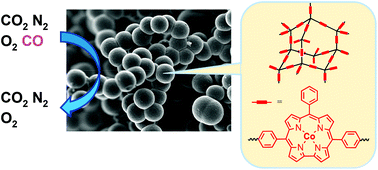Porous organic polymers based on cobalt corroles for carbon monoxide binding†
Abstract
Porous organic polymers (POPs), known for their high surface area and porosity, were prepared starting from tetraphenyl tetrahedral-shaped building blocks and corrole macrocyclic linkers either as free bases or cobalt complexes. This synthetic method allowed us to construct new porous frameworks with high carbon monoxide adsorption properties. Two synthetic strategies were developed for incorporating cobalt corroles into the porous matrix. The first method is based on the copper-free Sonogashira cross-coupling reaction between a free base diodo-corrole with a tetrahedral shaped derivative followed by cobalt complexation of the resulting material, leading to POP-CorCo-1. The second strategy consists of preparing POP-CorCo-2 by directly using in the coupling reaction the metalated cobalt corrole temporarily protected by two ammine ligands at the axial position. The design principles as well as the relationship between the structure and the selective CO adsorption performance are presented. The adsorption capacities and selectivities of CO were calculated from a multisite Langmuir isotherm model and using IAST theory. Spectroscopic studies (NMR, FTIR, UV-visible), kinetic sorption measurements and microscopic analyses made possible to provide a fairly complete description of the structure of the POPs, their porosity and the nature of solid–gas interactions. The POPs prepared by both methods show a high permanent porosity and outstanding CO sorption properties with a high selectivity over N2, O2 and CO2, up to 15 700, 4000 and 1800, respectively. The two POP-CorCo therefore offer confined molecular spaces for ascertaining a high accessibility of the metallocorrole active sites for gas binding on the cobalt atom, thus featuring high potential for applications in selective capture or sensing of CO versus N2, O2 and CO2.

- This article is part of the themed collection: Nitrogen Ligands


 Please wait while we load your content...
Please wait while we load your content...